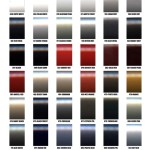Best Mold and Mildew Removers for Car Interiors: A Comprehensive Guide
Mold and mildew growth inside a vehicle's interior poses a significant health and aesthetic concern. The damp, enclosed environment of a car, especially after leaks, spills, or periods of high humidity, creates ideal conditions for these fungi to thrive. Selecting an appropriate mold and mildew remover is crucial for effectively eliminating the problem and preventing its recurrence. This guide provides information on identifying mold and mildew, understanding the factors that contribute to their growth, and evaluating the characteristics of effective cleaning products specifically designed for car interiors.
Addressing a mold or mildew infestation promptly is essential. Untreated mold can damage interior surfaces, cause unpleasant odors, and potentially trigger allergic reactions or respiratory problems in vehicle occupants. The porous nature of many car interior materials, such as upholstery, carpets, and headliners, makes them particularly susceptible to mold and mildew growth. Therefore, choosing a remover that not only cleans the surface but also penetrates and neutralizes the mold at its source is paramount.
Before selecting a product, it's important to distinguish between mold and mildew. While both are fungi, they exhibit distinct characteristics. Mildew typically appears as a flat, powdery growth, often white or gray in color. It tends to grow on surfaces and is generally easier to remove. Mold, on the other hand, often appears fuzzy or slimy and can be black, green, brown, or other colors. It penetrates deeper into materials and is generally more difficult to eradicate. Both require moisture to grow, so addressing the source of the moisture is critical to preventing future growth.
Identifying the Source of Mold and Mildew Growth
Pinpointing the source of moisture that enabled the mold or mildew growth is the first step in effective remediation. Common culprits include leaky windows or sunroofs, clogged air conditioning drains, spills that were not thoroughly cleaned, and leaving wet items, such as damp clothing or towels, inside the car. Ignoring the underlying cause will result in the mold or mildew returning, even after thorough cleaning. Inspecting all areas of the vehicle's interior, including under seats, inside the trunk, and around door and window seals, is necessary to identify any signs of water intrusion. Addressing these leaks or moisture sources will create a less hospitable environment for fungal growth.
Clogged air conditioning drains are a frequent contributor to mold and mildew growth. Condensation produced by the air conditioning system can accumulate in the drain and create a constantly damp environment. Over time, this moisture can lead to the development of mold and mildew within the ventilation system, leading to unpleasant odors and potentially distributing spores throughout the cabin. Regularly cleaning the air conditioning drain and ensuring proper airflow can help prevent this issue.
Another often-overlooked source of moisture is wet carpeting. Spills, tracked-in rain or snow, and even car washes can lead to damp carpets. If the moisture is not completely dried, it can create a breeding ground for mold and mildew, especially in areas under the seats or in the footwells. Regular vacuuming and the use of a wet/dry vacuum to extract excess moisture are essential for maintaining a dry and mold-free interior.
Evaluating the Characteristics of Effective Mold and Mildew Removers
Several key factors should be considered when selecting a mold and mildew remover for use in a vehicle's interior. The product should be effective at killing mold and mildew spores, safe for use on the specific surfaces being treated, and leave minimal residue or odor. It's also important to consider the potential health risks associated with the product and take appropriate precautions during application.
Effectiveness is paramount. A product should contain ingredients that are known to kill mold and mildew at the root. Look for products containing substances like bleach, quaternary ammonium compounds, or enzymatic cleaners. However, the use of bleach should be approached with caution, as it can discolor or damage certain materials, particularly fabric and leather. Quaternary ammonium compounds are often preferred for their effectiveness and lower risk of damage. Enzymatic cleaners are a more environmentally friendly option that break down the organic matter that mold and mildew feed on.
Safety is another critical consideration. The product should be safe for use on the specific surfaces being treated. Always test the product on an inconspicuous area before applying it to the entire surface. Some products may be too harsh for delicate materials like leather or suede. Pay close attention to the manufacturer's instructions and warnings. Furthermore, consider the potential health risks associated with the product. Some mold and mildew removers contain volatile organic compounds (VOCs) that can be harmful if inhaled. Ensure adequate ventilation when using these products and wear appropriate personal protective equipment, such as gloves and a mask.
Residue and odor are also important factors to consider. Some mold and mildew removers can leave behind a residue that attracts dirt and promotes future growth. Choose a product that is designed to rinse easily or that leaves a minimal residue. Similarly, some products have strong, unpleasant odors that can linger in the vehicle's interior. Opt for a product with a mild or neutral scent, or one that is specifically formulated to eliminate odors. Thoroughly ventilating the vehicle after cleaning can also help to remove any residual odors.
Types of Mold and Mildew Removers for Car Interiors
Several types of mold and mildew removers are available for use in car interiors, each with its own advantages and disadvantages. These include bleach-based solutions, quaternary ammonium compounds, enzymatic cleaners, and natural alternatives. Understanding the characteristics of each type can help in selecting the most appropriate product for a particular situation.
Bleach-based solutions are highly effective at killing mold and mildew, but they can also be harsh on certain materials. Bleach can discolor or damage fabric, leather, and vinyl. Therefore, it should only be used on surfaces that are not easily damaged by bleach, such as hard plastic or rubber. When using bleach, it is important to dilute it properly and to avoid prolonged contact with surfaces. Always wear gloves and eye protection when working with bleach.
Quaternary ammonium compounds are a safer alternative to bleach. They are effective at killing mold and mildew and are less likely to damage surfaces. These compounds work by disrupting the cell membranes of fungi, causing them to die. They are often found in commercial mold and mildew removers and are generally safe for use on a variety of surfaces, including fabric, leather, and vinyl. However, it is still important to test the product on an inconspicuous area before applying it to the entire surface.
Enzymatic cleaners are a more environmentally friendly option. They contain enzymes that break down the organic matter that mold and mildew feed on. This effectively starves the fungi and prevents them from growing. Enzymatic cleaners are generally safe for use on all types of surfaces and are less likely to cause damage or discoloration. They are also effective at eliminating odors associated with mold and mildew. However, they may require longer contact times to be effective.
Natural alternatives, such as vinegar, baking soda, and tea tree oil, can also be used to remove mold and mildew. Vinegar is a mild acid that can kill mold and mildew spores. Baking soda absorbs moisture and helps to neutralize odors. Tea tree oil is a natural antifungal agent. While these natural alternatives may be less potent than commercial mold and mildew removers, they are generally safer for use on delicate surfaces and are less likely to cause health problems. They may also require multiple applications to be fully effective.
Regardless of the type of mold and mildew remover chosen, it is essential to follow the manufacturer's instructions carefully and to take appropriate precautions to protect oneself and the vehicle's interior. Proper ventilation, personal protective equipment, and testing on an inconspicuous area are all important steps in the mold and mildew removal process. Addressing the underlying cause of the moisture problem is also crucial to preventing future growth.

Car Interior Cleaner Mold Remover Upholstery Seats Foot Mats Headliner Removal Cleaning And Maintenance Spray Com

Car Interior Cleaner Mold Remover Upholstery Seats Foot Mats Headliner Removal Cleaning And Maintenance Spray Com

Car Interior Cleaner Mold Remover Upholstery Seats Foot Mats Headliner Removal Cleaning And Maintenance Spray Com

Car Interior Cleaner Mold Remover Upholstery Seats Foot Mats Headliner Removal Cleaning And Maintenance Spray Com

Professional Mold Remediation For Car Interior Updated 2024 Guide

How To Remove Mold From Car Interior Montana Auto Pros

Miraclemist Instant Mold And Mildew Spray Remover For Rv Boat S Exterior Interior 1 Gallon Com

How To Remove Car Interior Mold Auto Detail Doctor

How To Get Mold Out Of Car Interior And Carpet

Miraclemist Instant Mold And Mildew Spray Remover For Rv Boat S Exterior Interior 1 Gallon Com
Related Posts








